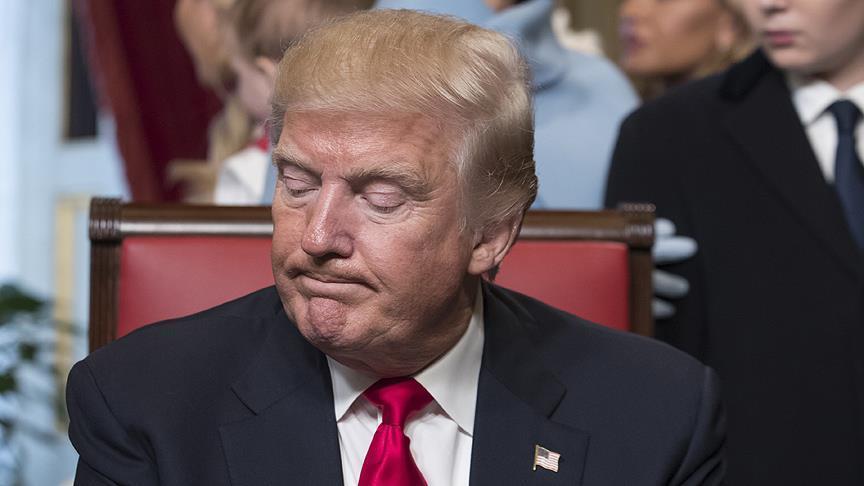President Donald Trump's negative approach to counter high oil prices has put his energy policies to the test as high crude prices continue to benefit the American oil industry, while helping Trump realize his energy goals.
Trump, who has long been a critic of high oil prices, said Saturday that he asked Saudi Arabia to increase its oil production in order to reduce prices on the global oil market.
"Just spoke to King Salman of Saudi Arabia and explained to him that, because of the turmoil & dysfunction in Iran and Venezuela, I am asking that Saudi Arabia increase oil production, maybe up to 2,000,000 barrels, to make up the difference...Prices too high! He has agreed!" Trump wrote on his Twitter account.
However, high crude prices, which are currently hovering around the $70-$80 a barrel mark, are helping Trump realize his policies in "starting a new energy revolution", "unleashing American energy" and "energy dominance."
When crude oil prices collapsed from $115 per barrel in June 2014 to below $30 a barrel in January 2016, investment of $250 billion vaporized in the American energy industry, 250,000 jobs were lost and some 300 companies declared bankruptcy.
With the rebound of oil prices last year, not only did the American oil sector recover, but the U.S. surpassed Saudi Arabia in February this year to become the world's second-largest crude oil producer after Russia.
High crude prices help American oil companies' finances and investments. Each barrel sold at a higher price means the possibility of more revenue and investments for companies, and greater ability to raise output.
Higher output and revenue means the gradual decline in U.S. dependence on foreign oil, further contributions to the American economy and employment, and more tax revenue for the federal government.
In addition, as U.S. oil production rises with higher prices, a unique opportunity is presented for the U.S. to increase its market share on the global oil market.
With pioneering technology and innovation, the U.S.' shale oil sector can quickly adapt to price fluctuations on the oil market.
Between Jan. 5 and June 22, the U.S. managed to increase its crude production from 9.5 million barrels per day (bpd) to 10.9 million bpd, marking a 1.4 million bpd increase in the span of less than six months, data compiled by Anadolu Agency, based on statistics from the Energy Information Administration (EIA) show.
After OPEC and non-OPEC countries agreed to raise their output levels 10 days ago, Saudi Arabia is expected to boost production by 500,000 bpd for the remainder of the year, while Russia is estimated to provide an increase of 150,000 bpd.
However, instead of taking steps to raise the U.S.' share on the global oil market through policies that would increase output even further, especially through higher crude exports, Trump has opted to seek Saudi Arabia's help in boosting production.
-Tariffs and trade war hamper US energy
Since taking office in January 2017, Trump has initiated some deregulation in the U.S.' energy sector to enable exploration and production in the Atlantic and the Arctic shelf.
However, the introduction of tariffs on steel and aluminum imports has hindered oil and natural gas pipeline projects by raising their costs. Such tariffs, if not lifted, could pressure the U.S.' ability to export its oil and gas in the long run.
In addition, by initiating a trade war with China, a negative impact on the U.S.' crude exports could be in the pipeline. After Trump’s $50 billion tariffs on Chinese imports, Beijing said it could retaliate with tariffs on U.S. crude oil.
China is one of the biggest importers of U.S. crude and has bought around 360,000 barrels per day during the October-March period of this year, official data shows.
Moreover, Trump's steel and aluminum tariffs have also hampered trade relations with Canada and Mexico - two countries that the U.S.' has very close energy trade with.
- Trump's "energy dominance" policy
The Trump administration's "energy dominance" policy is using higher oil and gas exports to increase the U.S.' influence in the geopolitical sphere.
When Trump met with Polish President Andrzej Duda in July 2017 in Warsaw, he said the U.S. could help this country wean its dependency off Russian energy "so that you can never be held hostage to a single supplier," while trying to extend the U.S.' power into Europe through its crude oil and LNG exports.
However, to achieve this, Trump needs oil prices to remain at their current levels so that American energy companies can generate further revenues for new investments and projects.
In short, by criticizing high oil prices and calling for Saudi Arabia to increase its production, Trump is creating obstacles for American companies' revenues and their dire need for investment.
His tariffs on steel and aluminum are creating higher costs for pipeline infrastructure at a time when the U.S. needs more export capacity to gain market share from Saudi Arabia.
And, the erosion of trade relations with neighboring Canada and Mexico seems destined to only create an impediment to the realization of his energy policies.
- Opinions expressed in this piece are the author’s own and do not necessarily reflect Anadolu Agency's editorial policy.By Ovunc Kutlu in New York
Anadolu Agency
energy@aa.com.tr


